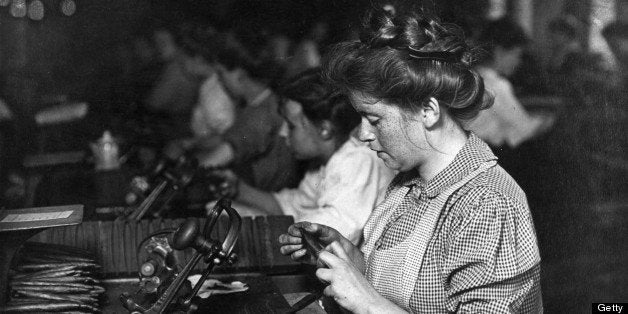
Over 100 years ago, radical writer and activist Emma Goldman penned the essay "The Tragedy of Woman's Emancipation." In the piece, which the Atlantic unearthed on July 12th, Goldman explores issues of equal pay, the tension between family life and home life, and the roadblocks that prevent true gender equality. Essentially, Emma Goldman sparked the original "having-it-all" debate.
So many of the issues Goldman raises feel nearly as relevant now as they must have then. Here are four things Goldman touches on that we're still working on today:
1. Men dominate many of the most esteemed professional fields -- and get paid more for their work.
"It is a fact that women teachers, doctors, lawyers, architects, and engineers are neither met with the same confidence as their male colleagues, nor receive equal remuneration," Goldman wrote. Today, women are still severely underrepresented in many fields -- especially in leadership positions. In 2004, only 16.8 percent of large law-firm partners were women. Only 1 out of every 7 engineering students is female, and women account for a pathetic 6 percent of chief executives of the top 100 tech companies. And in terms of remuneration, it's well established that women earn an average of 77 cents for every man's dollar.
2. Work stress disproportionately impacts women.
Emma Goldman wrote that to succeed in the workplace, “[women] generally do so at the expense of their physical and psychical well-being” –- a feeling that still resonates with many women and men today. But studies show that workplace stress may disproportionately impact women. The American Psychological Association's Work And Well-Being Survey, published in March of this year, found that 37 percent of women said they feel stressed at work (whereas 33 percent of men reported workplace stress) and that only 34 percent of women felt that they had enough resources to manage their stress (whereas 38 percent of men felt they had resources available to them).
But, it seems that women have begun to take control of this issue since Goldman’s time and are starting to have constructive conversations about how to handle stress -- weighing priorities, demanding flexibility and generally pushing back against stressful work environments.
3. The "freedom" the workplace supposedly offers women sometimes doesn't feel so free at all.
"How much independence is gained if the narrowness and lack of freedom of the home is exchanged for the narrowness and lack of freedom of the factory, sweat-shop, department store, or office?" Goldman asked. And when one considers the persistence of gender-based workplace discrimination, the workplace is not a place of freedom for many women. The gender-based wage gap, as well as the glass ceiling and occupational segregation are just a few of the factors which can make the workplace an frustrating rather than liberating place for some women.
4. Women are doubling up on work at home and outside of the home.
The "Second Shift" -- a term established by sociologist Arlie Hochschild in 1989, which refers to the disproportionate amount of unpaid domestic labor women do in addition to their paid jobs -- has apparently been around since Goldman's time. Goldman wrote, "In addition [to working] is the burden which is laid on many women of looking after a 'home, sweet home' -- cold, dreary, disorderly, uninviting -- after a day's hard work."
In June of this year, the Bureau of Labor Statistics reported that the "second shift" is still a problem. Only 20 percent of men reported helping out with housework (such as cleaning and doing laundry), while 48 percent of women said the same. And while 39 percent of men said that they helped out with food preparation and cleanup, 65 percent of women said that they regularly prepared meals. In Lean In, Sheryl Sandberg points to this second shift as a serious blockade to women's progress, encouraging women to stop being "maternal gatekeepers" and encourage their partners to take on greater responsibilities at home.
Goldman wraps up her essay with an eerily prescient summary of the issues she feels women of her generation faced:
The narrowness of the existing conception of woman's independence and emancipation; the dread of love for a man who is not her social equal; the fear that love will rob her of her freedom and independence; the horror that love or the joy of motherhood will only hinder her in the full exercise of her profession -- all these together make of the emancipated modern woman a compulsory vestal, before whom life, with its great clarifying sorrows and its deep, entrancing joys, rolls on without touching or gripping her soul.
Luckily, Goldman's essay not only reminds us of the things we still need to work on, but highlights how far we've come. Women are pushing back and engaging in productive dialogues about how we can further progress -- both in and out of the office, and thought leaders like Sheryl Sandberg are encouraging women to demand the compensation they deserve. There's more work to be done, but we're well on our way.

